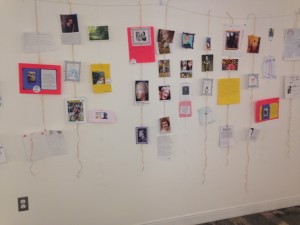 I traveled to the National Liberty Museum as my Women’s History Month event. I chose to travel here because online it said that they would have a special exhibit dedicated to Women’s History Month. I chose to come to this event because I had never been to the National Liberty Museum and thought it would be interesting. It was also pay as you wish month, so as a poor college student this appealed to me. Unfortunately, I was less than impressed.
I traveled to the National Liberty Museum as my Women’s History Month event. I chose to travel here because online it said that they would have a special exhibit dedicated to Women’s History Month. I chose to come to this event because I had never been to the National Liberty Museum and thought it would be interesting. It was also pay as you wish month, so as a poor college student this appealed to me. Unfortunately, I was less than impressed.
I think what disappointed me in this event, was not what it was but how small it was. I knew going into it, and doing my research on the event online it was going to be a wall of all these different women that people see as heroes. I thought that when I saw it I would be amazed because online they invited people to send pictures in from all around the world, and add some if you were to come to the museum. This wall of pictures was very small. There were at most thirty pictures on the wall, and honestly most of them were people’s personal pictures or drawings. I was hoping there would be more known women throughout the years with more historical influence.
There were some things nice about the exhibit. I thought that people could bring in their own pictures or draw their own, added a really nice personal aspect to the exhibit. The theme of the National Liberty Museum is heroes, so it was all about why these women were heroes. This reason did make it enjoyable to read not only the historical women, but to read and learn about why people’s mothers and grandmothers were heroes.
One of the women that was on the wall was Malala Yousafzai, who I think it was one of the most influential women of our time. Malala was born in 1997, in Pakistan.[1] Malala began speaking out about her opposition for the Taliban’s resistance for education, especially for women.[2] Malala and her father both received death threats, but this did not stop them for speaking out.[3] In October 2012, Malala went to school and on her way home she was hunted down and shot by a gunman.[4] This incident gained a lot of attention in the news, which prompted over two million people to sign the right to education petition.[5] After Malala healed, she was seen on many different TV programs talking about what she stands for. The way she stuck up for women, makes her a very influential and notable women from our time.
I think the fact that the exhibit did not impress me continues the trend that is seen with women. Throughout the Women’s history they have continually been pushed to the side and have been forgotten about. They haven’t got the same rights as men including the right to vote. They also had to fight hard and put up strikes to get workers rights. When it comes to dealing with women it does not seem like the same energy is put in. This is why this exhibit disappointed me, because it just did not seem like time was put into it. To make this exhibit better, I think more research could have been put into it. They could have gathered more pictures of influential women throughout history, and they could have put some more information of them on the back of the pictures so we could learn about them. I did not need the whole museum dedicated to women for the month of March, but it would have been nice if what they dedicated to women to feel like more effort was put in.
Overall, I was not impressed by the National Liberty Museum’s Women’s History Month exhibit. It was nice that they did showcase some influential women, like Malala Yousafzai, but they could have added more. The exhibit fit with the theme of the museum, but it would have been nice if they put more effort into the exhibit.
Biblography
“The Malala Fund.” The Malala Fund. Accessed March 31, 2016.
https://www.malala.org/malalas-story.
[1] “The Malala Fund.” The Malala Fund. Accessed March 31, 2016. https://www.malala.org/malalas-story.
[2] Ibid.
[3] Ibid.
[4] Ibid.
[5] Ibid.
